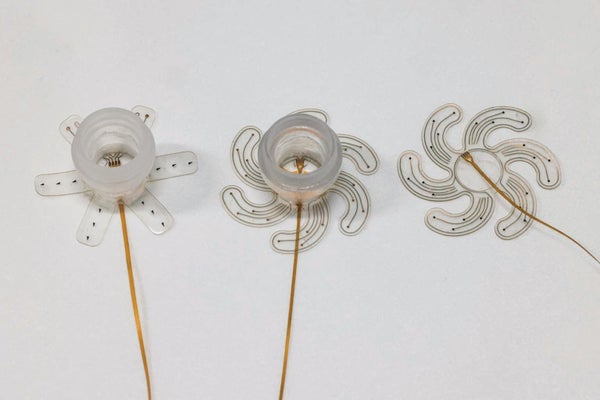Scientists have made great strides in developing soft “biocompatible” electrodes. But comparatively less attention has gone toward how to actually get these devices—which have wide applications in brain-machine interfaces, such as for controlling prosthetic devices—inside people's heads. Researchers led by Stéphanie Lacour, a neurotechnologist at Switzerland's Ecole Polytechnique Fédérale de Lausanne (EPFL), presented an ingenious solution to this problem in Science Robotics.
Electrode arrays that sit on the brain's surface are most often used to map seizure-related brain activity in people with epilepsy. This technique requires arrays that cover relatively large areas, necessitating removal of at least an equal area of skull in a procedure known as a craniotomy.
The implant Lacour and her colleagues built is instead inserted through a much smaller hole in the skull. “It really solves a major, long-standing practical problem … with a solution simple enough it seems realistic to translate to the clinic,” says Chalmers University of Technology bioengineer Maria Asplund, who was not involved in the study but wrote an accompanying commentary.
On supporting science journalism
If you're enjoying this article, consider supporting our award-winning journalism by subscribing. By purchasing a subscription you are helping to ensure the future of impactful stories about the discoveries and ideas shaping our world today.
The implant is made of a stretchable “elastomer” material that mimics the dura, the membrane surrounding the brain. The study's lead author, Sukho Song, an engineer also at EPFL, borrowed a technique called eversion from soft robotics to add a novel deployment mechanism: Initially the electrode array's “arms” are tucked inside a cylindrical loader like the fingers of an inverted glove. Once the loader is inserted in the small hole, fluid pressure drives each arm to extend horizontally in the one-millimeter space between the skull and the brain. A strain sensor signals full extension.
The team used a physical brain-and-skull model to work out the best shapes and dimensions to maximize coverage while minimizing tissue compression. The current prototype fits through a two-centimeter hole and extends six spiral-shaped arms, enabling even coverage of a four-centimeter-diameter area.
The most similar previous effort, built for the spinal cord, would take up too much space if used in the brain. “What's added here is that the implant makes only the movement you'd like it to,” Asplund says. “It should have minimal volume and expand only in one plane.”
The researchers tested the technique by implanting a simpler device with one straight arm in a miniature pig. They positioned it over the somatosensory cortex, which processes touch, and confirmed that appropriate signals registered when the animal's snout was stimulated. They saw no visible signs of brain damage afterward, although microscopic investigation revealed a very slight immune reaction. “This has to be pursued further,” Lacour says, “but these are encouraging first steps.”
A spinoff company, Neurosoft Bioelectronics, is working on clinical applications. “They're making good progress toward medical-grade fabrication,” Lacour says. “And they're in discussion with regulatory bodies.”
